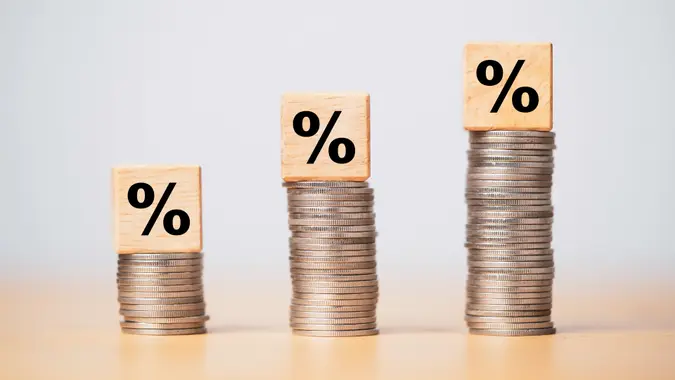What Is a Compound Interest Savings Account?

Commitment to Our Readers
GOBankingRates' editorial team is committed to bringing you unbiased reviews and information. We use data-driven methodologies to evaluate financial products and services - our reviews and ratings are not influenced by advertisers. You can read more about our editorial guidelines and our products and services review methodology.

20 Years
Helping You Live Richer

Reviewed
by Experts

Trusted by
Millions of Readers
A compound interest savings account is an account that pays you interest not just on your initial deposit, but also on any interest that deposit has earned.
Albert Einstein famously called compound interest “the eighth wonder of the world.” Knowing how compound interest accounts work is key to making your money work exponentially better for you over time.
How Does Compound Interest Work?
Compound interest allows you to earn interest on the amount you’ve originally deposited. This is known as your principal. You also earn interest on any earnings you’ve made over time. To put it simply, you earn interest on your interest.
Here’s how simple interest works compared to compound interest:
- You deposit $100 into an account with a 4% interest rate.
- You don’t make another deposit into the account.
- At the end of the first year, you’ll have $104 — the initial deposit of $100, plus $4, at 4% simple interest.
- At the end of the second year, you’ll have $108 — the beginning balance of $104 from the end of the first year, plus another $4 in simple interest on your initial deposit.
- No matter how large your balance grows, you’ll never earn more than $4 interest in any given year unless you deposit more money into the account.
Now, compare that to compound interest:
- You deposit $100 into an account with a 4% annual percentage yield — meaning the effective rate after compounding is 4%.
- You don’t make another deposit into the account.
- The interest is compounded monthly.
- At the end of the first year, your account balance will be $104.07 because your interest will have earned interest through monthly compounding.
- At the end of the second year, you’ll have $108.31.
- Your interest earnings will continue to increase each year, even if you never make another deposit.
It’s easy to see how savings can add up quickly when you choose an account with compound interest. It is the closest thing you will find to free money.
Good To Know
Some accounts only offer simple interest. Simple interest means you only earn money on your balance, not on the interest. So, if you have an account that offers 4% interest and you deposit $100, you’d earn just $4 each year. The only way you could increase your interest earnings would be to make another deposit into your account.
How the Frequency of Compounding Affects Your Interest Earnings
The example above used a monthly compounding period. Other common compounding periods include daily, quarterly, semi-annually and annually. Shorter compounding periods can grow your money faster.
How To Calculate Compound Interest
Here’s the formula used to calculate compound interest:
Compound Interest Formula
A = P (1 + r/n) (nt)
For example, say you’ve just opened a bank account. How much would $1,000 at 4.00% compounded monthly over two years give you?
- A = 100(1 + 0.04/12)12×2
- A ≈ $1,083.29
That’s approximately $1,083 earned. That shows the benefit of compounded interest. You can still make money, even without adding onto your principal.
You can also use a compound interest calculator like the one available here to find out your compound interest over time.
Benefits of Opening a Compound Interest Account
Many different account types can provide you with a safe place to keep your money. But compound interest accounts have unique advantages.
Maximizing Your Earnings With Compound Interest
When all else is equal, compound interest accounts are always better than simple interest accounts. Combine compound interest with high yields, such as the ones high-yield savings accounts offer, to maximize your interest earnings.
Long-Term Benefits: How Your Savings Grow Exponentially
Compound interest accounts produce a snowball effect on your savings. The more you save, the faster your interest earnings accumulate.
Advantages Over Regular Savings Accounts
The comparison used earlier showed a low deposit amount and short time frame, so compounding resulted in just a few cents more in interest earnings than a simple interest account provided. However, if you increase the initial investment to $500 or $1,000 or more, and factor in monthly contributions over many years, the benefits of a compound interest account become even more apparent.
Types of Accounts That Offer Compound Interest
The good thing is many different account options compound interest, so you can choose the one account or combination of accounts that best meets your needs.
Savings Accounts With Compound Interest
Savings accounts are a safe place to keep and grow money. You can put this money aside for later use. Because savings accounts provide near-instant access to your money, they’re a good choice for emergency savings and funds you’ll use in the not-too-distant future.
Certificates of Deposit and Their Compounding Benefits
Unlike a savings account, which lets you withdraw money on demand, a CD locks up your money for a predetermined period of one month to five years or more. In return, you’ll typically earn higher rates from a CD than you’ll get with a savings account.
As of April 2025, 12-month CD terms have the highest average rate — 1.78%, compared to 0.41% for a savings account, according to the Federal Deposit Insurance Corp.
Retirement Accounts and Compound Interest: IRA vs. 401(k)
Individual retirement accounts and 401(k)s may compound your interest or investment returns.
An IRA is a tax-advantaged account you can open independently through a bank or investment brokerage. You can invest your contributions in any number of assets, including money market accounts, money market funds, mutual funds and individual stocks and bonds.
A money market account is similar to a compound interest savings account — you’re essentially holding that money as cash and earning compound interest on your entire account balance. Money market funds and other investment assets, on the other hand, are investment products that can appreciate, pay dividends or both. As long as you reinvest the gains, future gains are compounded.
A standard 401(k) has the same tax benefits and compounding perks as IRAs. However, a 401(k) is an employer-sponsored account that you can only get at work. While the IRS allows higher contribution limits for 401(k)s than for IRAs, investments are usually limited to select money market accounts and mutual and exchange-traded funds selected by the plan administrator.
Features To Look For in a Compound Interest Account
Certain features serve as good points of comparison when you’re selecting a compound interest account.
Comparing Interest Rates and Annual Percentage Yields
The interest rate refers to the amount of simple interest an account earns. An annual percentage yield is the rate you earn after compounding. It’s a more accurate way to compare accounts.
Account Fees and Their Impact on Your Return
Some banks charge customers monthly maintenance fees just for having accounts. These fees typically range from roughly $5 to $25, depending on the bank and the account, and they can cost you more than you stand to gain in interest.
Consider This
Consider this: A $5 monthly fee equals $60 per year. You’d need a $14,500 balance earning the average savings account interest rate of 0.42% to earn enough interest to cover that fee — with $1.03 to spare.
Other fees to consider include overdraft and overdraft protection.
Accessibility and Withdrawal Limitations
Easy access to your money is an important consideration if you’ll tap into your savings regularly. Before April 2020, federal law limited convenience withdrawals from savings accounts, including money market accounts, to six per statement period. The Federal Reserve lifted that mandate to give consumers more access to their money during the pandemic, but some banks still impose the limit and charge a fee for excess withdrawals.
Strategies To Maximize Your Compound Interest Earnings
How you select and manage your compound interest accounts can impact your earnings. Use these tips to get the most from your savings and investments.
- Select accounts with more frequent compounding: Daily compounding earns you more interest than monthly, semi-annual or annual compounding.
- Automate your contributions: Setting up your checking account or direct deposits for automatic contributions to your savings and retirement accounts helps to ensure steady growth.
- Diversify your investments: Dividing your money between different types of bank accounts and investments is a great way to offset risk while improving your gains.
Risks and Considerations When Using a Compound Interest Account
Most people are familiar with the risks of investing in stocks and bonds — if the value of your investment decreases, you lose money. However, you might not realize that even the safest compound interest accounts, such as savings accounts and CDs, also have some risk.
- Inflation risk: Inflation robs your money of purchasing power. With a 2.5% inflation rate, for example, $100 of today’s savings will only buy $97.50 worth of goods and services a year from now.
- Financial institution risks: The FDIC insures bank deposit accounts for up to $250,000 per depositor , per account category. The National Credit Union Administration provides the same protection for credit union share accounts. You’re only eligible for one or the other if your financial institution is a member, though. Otherwise, your money could evaporate if the financial institution fails.
- Fees and penalties: Account maintenance fees, overdraft fees and other fees and penalties chip away at your balance and reduce the amount of interest you earn on your money. That’s true whether your account is earning simple interest or compound interest. But they hit compound interest accounts harder by also erasing gains on your gains.
Top Banks Offering the Best Compound Interest Accounts in 2025
GOBankingRates recently named Best Banks for 2025 across many categories of banks and bank accounts. The winners’ APYs range from 0.01% to 5%. Here’s how savings accounts from a few of the top banks compare.
Truist One Savings Account
Truist’s Truist One Savings Account earns APY on all balances. It has a minimum opening deposit of $50, and a $5 monthly fee that Truist offers several ways to waive. Pairing the account with a Truist One Checking account lets you schedule auto transfers into your savings and qualify for special relationship banking perks.
U.S. Bank Smartly Savings
U.S. Bank Smartly Savings account customers earn APY on their balances and can earn up to APY with relationship banking. The account has a $25 minimum opening deposit and a waivable $5 monthly fee. Digital budgeting tools make your account easy to access and maintain.
Varo High-Yield Savings
Varo is an online bank that pays APY on up to $5,000 of savings when you receive $1,000 in direct deposits into its high-yield account. After that, the APY drops to a still-competitive APY. The account has no fees. Automatically round up purchases you make from the account to grow your savings faster.
Here’s a comparison overview of the above savings accounts.
SELECTED BANK
MOST COMPARABLE
MOST COMPARABLE
Fees
Fees
Fees
$5, waivable
No monthly service fee
None
APY
APY
APY
Up to
Up to
Min Opening
Min Opening
Min Opening
$25 to $50
$25
$0
Is a Compound Interest Account Right for You?
Compound interest supercharges your savings by paying you interest on both deposits and the interest the account has earned. Fortunately, most bank and investment accounts earn compound interest or gains, so maximizing your earnings comes down to looking at APYs, fees and other account features. Compare a few accounts, perhaps starting with GOBankingRates Best Banks of 2025, then open the best account for your needs to start building your financial future with compound interest.
FAQ on Compound Interest Accounts
Here are the answers to some of the most frequently asked questions regarding compound interest accounts.- Can you get a compound interest savings account?
- Most banks, neobanks and credit unions offer compound interest savings accounts. Not every bank lists its offering as compound savings, so you may have to read the fine print.
- While it's typically better to find a compound interest account, an account with a 4% interest rate, compounded annually, is better than a 0.01% account where interest is compounded daily.
- When choosing a compound interest savings account, you can compare annual percentage yields to find the best return.
- What bank has a compound interest savings account?
- Many banks offer compound interest savings accounts, and Discover has one of the best. You can earn an APY of 3.50% and interest compounded daily and paid monthly — and no monthly fees.
- Where can I get 7% interest on my money?
- Most banks do not offer interest rates as high as 7% on checking or savings accounts. Landmark Credit Union advertises 7.50% interest on their checking account, but it's only available on balances up to $500. Customers must agree to receive eStatements and must have direct deposit of at least $250 per month.
- For higher earnings, investors typically look to the stock market. The annualized return of the S&P 500 over the past 30 years is 9.9% when you reinvest dividends.
- How much is $1,000 worth at the end of 2 years if the interest rate of 6% is compounded daily?
- If you put $1,000 into a compound interest savings account offering 6% interest compounded daily, after two years, you would have earned $127.49. This would bring your account total to $1,127.49.
- That may not sound like, but it represents $127.49 in free money earned by choosing the right investment. After 20 years, you would have $3,319.79.
Dawn Allcot contributed to the reporting for this article.
Rates are subject to change; unless otherwise noted, rates are updated periodically. All other information on accounts is accurate as of April 4, 2025.
Our in-house research team and on-site financial experts work together to create content that’s accurate, impartial, and up to date. We fact-check every single statistic, quote and fact using trusted primary resources to make sure the information we provide is correct. You can learn more about GOBankingRates’ processes and standards in our editorial policy.
- Investor.gov. "Compound Interest Calculator."
- FDIC. "Deposit Accounts."
- FDIC. 2024. "National Rates and Rate Caps."
- Fidelity. "The power of continuous contributions and compounding."
- Citizens Bank. "IRA vs. 401(k): What's the difference and how to choose one."
- SoFi. 2025. "APY vs Interest Rate."
- CNBC. 2024. "7 common banking fees and how to avoid them."
 Written by
Written by  Edited by
Edited by 




























